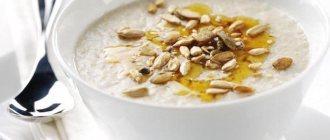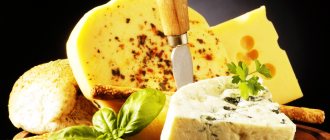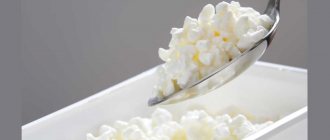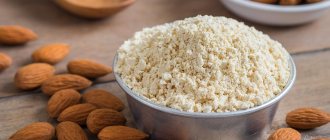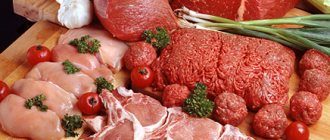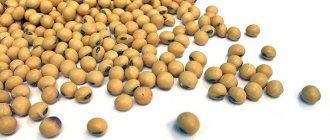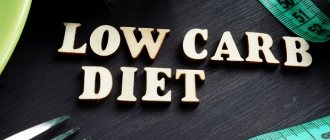Why is it not necessary to look at the fat content of cheese in dry matter?
Because you're eating a piece of cheese, not a piece of dry matter. It is worth noting that the standard fat content of cheese is 50-60g or 50-60% in dry matter. Many people take the percentage of fat content indicated on the packaging literally. Those. I ate 100g of 50% cheese, which means I got 50g of fat (450kcal). Wow! 40 minutes on the elliptical! But that's not true!
So, if it is indicated that the fat content of Swiss cheese is 50%, this means that 100 g of cheese contains 32.5 g of fat (in cheese of this type, per 100 g of weight there are usually 65 g of dry matter, 50% of which will be 32. 5 g).
How to choose
Diet cheese should be selected according to the percentage of fat content; if you want to lose, rather than gain, excess weight, a product containing no more than 30% fat is suitable for you. It happens that smaller numbers are indicated on the packaging of some varieties, but then you need to pay attention to the calorie content. Often this figure exceeds the acceptable norm for weight loss. Foods with a spicy or excessively salty taste are not suitable for the diet.
High-quality cheese should have a uniform color (without stains or signs that it has been washed or cleaned), a fresh smell, intact packaging and not contain palm oil or vegetable fats. Pay attention to the cut of the product: smooth, non-crumbling edges indicate freshness (with the exception of the Idiazabal variety). It is also important not to overdo it with the amount of cheese during consumption, otherwise even the most low-fat varieties of cheese will add extra centimeters during your diet.
g fat in 100 grams of cheese
Soy cheese Tofu with dill and garlic2.5g Grain cottage cheese “Domashny”, karat 4g Valio Polar 5g President melted cream cheese light 7g Meadow freshness - Light 9g Bulgarian cheese 11g Cheese Gallery Light 11g Bonfesto soft cheese "Ricotta" 11.5g Cheese "Homemade Light", Karat - natural 12 gKRAFT PHILADELPHIA light cheese12gSirtaki brine cheese for Greek Classic salad 13.3g Cheese “Light”, “Thousand Lakes” 15g Cheese Casket light 15g Cheese Arla Natura Light creamy 16g Cheese President Brynza 16.7 g Cheese Svitlogorye “Fetu” 17.1 g Cheese President Chechil White Straw 18 g Cheese President Chechil White Spaghetti 18 g Cheese Ugleche Pole brine cheese for 18gBellanova brine product Delicacy Bella18gBonfesto cheese Mozzarella18gUmalate Unagrande Caccioricotta18gCheese Lactica “Adygei” 18g President processed cheese Sliced Mozzarella 19.5g Lactica cheese “Suluguni” 22g Suluguni cheese Meadow freshness pancakes 23gHard cheese Light 30% fat
Farm "Dolyubovo" offers light cream cheese with excellent taste and aroma. The product has a low fat content and reduced calorie content. It is excellent for dietary nutrition.
The recipe is similar to Atlet cheese, created by Estonian manufacturers for sports nutrition. It contains many vitamins and minerals to nourish and maintain body functions.
Light cream cheese has a fat content of up to 30%, has a bright pleasant taste and low calorie content. The nutritional value per 100 g is only 250 kcal, the package contains 200 g of product.
The product contains 27.9 g of protein per 100 g. This is a useful element for maintaining beautiful muscles for anyone involved in professional sports or individual training.
Soy cheese tofu 1.5-4%
Although it is made on the basis of soy milk, tofu is classified as curd cheese, since in color and consistency it resembles low-fat and unsalted feta cheese.
Tofu is rich in high-quality proteins, so it can successfully replace meat. Calcium, present in abundance in this product, has an excellent effect on the bone skeleton, which makes tofu an ideal product for consumption by older people in order to prevent diseases such as osteoporosis.
In addition, 100 grams of tofu cheese contains only 90 calories, so it is recommended to include it in the diet menu.
Many celebrities have replaced dairy products and cheeses with soy in their diet, so many diets have now been developed that involve a reduced consumption of classic cheeses, while tofu is recommended for daily consumption along with foods of plant origin.
A number of nutritionists also claim its healing properties, because it has already been proven that it helps reduce the level of “bad” cholesterol (LDL) in the blood, which helps prevent many cardiovascular diseases.
With what and how to eat? Suitable for miso soup, salads.
Cheese without salt. Eating cheeses and how not to buy counterfeit ones
Natural unsalted hard cheeses are unique storehouses of the most essential nutrients for the human body:
• protein; • saturated animal fats; • B vitamins; • vitamins A, D; • calcium; • potassium; • phosphorus; • magnesium, etc.
This makes this type of cheese an indispensable healer for diseases of the stomach, intestines, endocrine glands, and problems with the hematopoietic and cardiovascular systems. This product occupies a special place in dietary nutrition, preparing diets for athletes, children, and older people.
Unsalted hard cheese finds its rightful place in almost all culinary cultures of the world. It is most unsurpassed as a stand-alone dish or snack. As an ingredient included in salads, soups, hot dishes, sandwiches, pies, sauces, spreads, pizza, pasta, desserts, baked goods, it has no equal. It is an integral option in product lists for various diets. The fact that nutritionists recommend unsalted hard cheese as a food for complementary feeding for babies indicates its significant benefits.
What kind of cheese should be served with wine, cognac, fruit, fresh pastries?.. Of course, unsalted hard cheese, which is capable of soloing or talentedly playing along with the entire culinary orchestra.
Unsalted durum varieties are considered low-calorie and contain the maximum amount of nutrients. They are recommended for nutrition for those who want to regulate their own weight, people with diseases of the gastrointestinal tract (GIT), patients prone to swelling and having problems with the urinary system.
It's all about natural products. How to distinguish real cheese from artificial cheese? First of all, for the price. To prepare a kilogram of product you will need at least 15 liters of natural milk, the presence of natural lactobacilli and rennet starter. The minimum ripening period is about 2 months. So consider it.
The ingredients listed on the label of this product may include:
• milk; • natural starters from microorganisms and (or) animal enzymes; • sodium chlorine.
But what components characterize the unnaturalness of the product:
• milk substitutes; • soy ingredients; • vegetable oils, including palm, coconut; • flavor enhancers, stabilizers, preservatives, dyes, etc.
So before buying unsalted hard cheese, you should think: which is better? Purchase 200 g of a valuable, irreplaceable and useful product. Or save money and harm your own body and wallet. After all, a fake is also not a cheap product.
The fact that 50 g of natural unsalted hard cheese can easily replace the daily intake of vitamins, macro- and microelements speaks for itself.
Curd cheese, country cheese, grain cottage cheese - in English. cottage cheese 4-5%
Grained cottage cheese is a type of low-fat cottage cheese. It is a curd grain mixed with fresh, slightly salted cream.
Can be used as an independent dish, as well as for preparing various salads (for example, vegetable salad with grain cottage cheese). In Russia it is sometimes found under the unofficial names “grainy cottage cheese” and “Lithuanian cottage cheese”.
In the USA, Europe and Asia, grained cottage cheese is called cottage cheese. It is often called homemade cheese. At first glance, cottage cheese looks like fresh cottage cheese, but its texture is much softer, one might even say creamy, and its taste is a little saltier.
100g of grain cheese will provide our body with 85 calories and 17g of protein, so nutritionists recommend it even if you follow the strictest diets.
With what and how to eat? Without additives, in salads, in cottage cheese omelettes.
Price
Diet-friendly varieties of low-fat cheese are more expensive than regular cheeses, since special techniques are used for their production. The cost of such products in different retail chains may differ; in stores in the Moscow region it is as follows:
| Name | Price in rubles |
| Sernur Ricotta herbes de Provence, 200 g | 85 |
| Russian, 300 g | 195 |
| Cheese cheese, 320 g | 192 |
| Mozzarella, Rossini, 250 g | 157 |
| Cheese cheese 45%, 500 g | 350 |
| Adyghe, 450 g | 290 |
| Cheddar, Hochland, 1.04 kg | 707 |
| Parmesan, Dolce, 300 g | 390 |
| Dutch, 350 g | 396 |
| Parmesan 32%, Cheese Gallery, 175 g | 256 |
| Parmesan 40%, Skorobogatov, 270 g | 340 |
Whey cheese - ricotta 9-18%
Ricotta is an invariable component of Italian breakfast. This cheese contains no salt. Due to its high nutritional value and impressive composition of vitamins and microelements, ricotta gives a quick feeling of fullness.
This type of curd cheese is recognized as a protector of our liver; it contains methionine, a sulfur-containing amino acid.
With what and how to eat?
This cheese is good with fresh vegetables and fruits, honey, ham, pasta, basil, salmon, broccoli. It is customary to stuff pancakes and pancakes with it.
Low-fat granular cottage cheese (fat content 5%)
Crumbly granular cottage cheese contains only 5% fat, so it is suitable for those losing weight. It is also high in calcium, protein and gut-healthy bacteria.
Grainy cottage cheese can be consumed as an independent dish; you can add fruits and berries to it, put it in salads, make cottage cheese casseroles and omelettes.
100 g of this cheese contains only 85 kcal and approximately 17 g of protein, which makes it easy to comply with the protein quota prescribed by nutritionists. 200 g of grainy cottage cheese will cover the protein intake in one meal - do not forget about this when planning a proper and balanced snack.
Brine cheese like feta - light cheese, feta 11-18%
This cheese is a traditional product of Greek cuisine. But it is eaten with pleasure in many other countries, including ours. Feta is considered a fatty food, high in cholesterol and has a calorie content of approximately 260 kcal/100 gm.
But not everyone knows that the feta cheese they adore is produced in a light version, although, admittedly, this particular variety is difficult to find on supermarket shelves.
However, the effort you put into searching will be fully worth it. Feta light is usually made from goat's milk and contains only 30% fat, while traditional feta is made from sheep's milk and is then 60% fat.
With what and how to eat?
It is usually added to Greek salad along with vegetables and olives, or it is used in Caprese salad, where it replaces mozzarella. Usually served with olives.
These cheeses also go well with tomatoes, sweet peppers, onions, watermelon, spinach, rosemary, mint, oregano, tuna, and baked chicken. And when preparing Greek salad they are simply irreplaceable!
Maybe it will be useful to someone!!! 8 varieties of low-fat cheese...
8 Low-Fat Cheeses
Low-fat cheese is a non-existent concept. Any cheese contains fat, the only difference is in its amount. Let's find out: which cheese is the lightest?
Low-fat cheeses
Anyone who cares about their figure chooses high-quality products with low fat content. And this is the right tactic. Less fat, flour and sweets... and more movement - this is the formula for slimness.
To maintain a slim silhouette, it is better to replace your beloved Roquefort with something less nutritious, sometimes even curd cheese.
It is worth noting that the standard fat content of cheese is 50-60g or 50-60% in dry matter, while we offer cheeses with reduced fat content up to 30 g of fat in dry matter. You need to look for such cheeses either in hypermarkets or in expensive grocery stores.
1. Low-fat cheese - tofu-soy cheese (fat content 1.5-4%)
Although it is produced on the basis of soy milk , tofu is classified as curd cheese, since in color and consistency it resembles low-fat and unsalted feta cheese. Tofu is rich in high-quality proteins, so it can successfully replace meat. Calcium, present in abundance in this product, has an excellent effect on the bone skeleton, which makes tofu an ideal product for consumption by older people in order to prevent diseases such as osteoporosis.
In addition, 100 gm of tofu cheese contains only 90 calories, so it is recommended to include it in the diet menu. Many celebrities have replaced dairy products and cheeses with soy in their diet, so many diets have now been developed that involve a reduced consumption of classic cheeses, while tofu is recommended for daily consumption along with foods of plant origin.
A number of nutritionists also claim its healing properties, because it has already been proven that it helps reduce the level of “bad” cholesterol (LDL) in the blood, which helps prevent many cardiovascular diseases.
2. Low-fat cheese - grain cottage cheese (fat content 5%)
Grained cottage cheese is a type of low-fat cottage cheese. It is a curd grain mixed with fresh, slightly salted cream. Can be used as an independent dish, as well as for preparing various salads (for example, vegetable salad with grain cottage cheese).
In Russia it is sometimes found under the unofficial names “grainy cottage cheese” and “Lithuanian cottage cheese”. In the USA and European countries (and not only English-speaking ones), grain cottage cheese is called cottage cheese .
It is often called homemade cheese. At first glance, cottage cheese looks like fresh cottage cheese, but its texture is much softer, one might even say creamy, and its taste is a little saltier. 100 g of cottage cheese will provide our body with 85 calories and 17 g of protein, so nutritionists recommend it even if you follow the strictest diets.
3. Low-fat cheese - Gaudette (fat content 7%)
Gaudette, Scherdinger's new low-fat cheese, is an easy indulgence for those seeking a healthy lifestyle.
Semi-hard Gaudette cheese contains only 7% fat (15% dry matter). This cheese with a soft, subtle, somewhat piquant taste is ideal for lovers of the famous Gouda cheese. In addition, cheese is easily digestible and has a high calcium content. Therefore, this cheese must be present in the diet of every cheese lover.
4. Low-fat cheese - Chechil (fat content 5-10%)
Chechil is a fibrous pickled cheese with a consistency similar to suluguni. It is produced in the form of dense, fibrous threads, twisted into tight braids in the shape of a pigtail, often smoked. Chechil is often mixed with cottage cheese or other cheese and stuffed into jugs or wineskins.
In appearance, this cheese has nothing in common with any other. It is produced in the form of fibrous threads tied into a bundle. Chechil ripens in brine, but is often mixed with cottage cheese or other cheese and stuffed into unglazed jugs or wineskins.
The taste and smell of this cheese are sour milk, sharp, the fibrous dough is dense, the surface of the product is rough. It contains up to 10% fat, no more than 60% moisture, and 4-8% salt.
5. Low-fat cheese - Viola Polar, Grünlander, Fitness (fat content 5-10%)
Such cheeses are a godsend for those losing weight! But you need to look for them in large stores. Study the back of the package in more detail - the label, some cheeses contain 5% yogurt, not fat!
6. Low-fat cheese - Ricotta (fat content 13%)
Ricotta is an invariable component of Italian breakfast. It is often called cheese, but this is not entirely true: after all, it is not made from milk, as we used to think, but from whey remaining after the preparation of other cheeses.
A slice of ricotta contains, on average, 49 calories and 4 grams of fat, half of which is saturated. This product contains the lowest amount of sodium compared to other cheese products. Due to its high nutritional value and impressive composition of vitamins and microelements, ricotta gives a quick feeling of fullness. In addition, this type of curd cheese is recognized as a protector of our liver, because it contains methionine, a sulfur-containing amino acid.
7. Low-fat cheese - light cheese, feta (fat content 5-15%)
This cheese, or rather even feta cheese, is a traditional product of Greek cuisine. But it is eaten with pleasure in many other countries, including ours. Feta is considered a fatty food, high in cholesterol and has a calorie content of approximately 260 kcal/100 gm. But not everyone knows that the feta cheese they adore is produced in a light version, although, admittedly, this particular variety is difficult to find on supermarket shelves.
However, the effort you put into searching will be fully worth it. Feta light is usually made from goat's milk and contains only 30% fat, while traditional feta is made from sheep's milk and is then 60% fat. It is usually added to Greek salad along with vegetables and olives, or it is used in Caprese salad, where it replaces mozzarella.
If you do not consume feta in combination with high-fat foods, then it can be recommended as quite suitable for a diet.
8. Low-fat cheese - Arla, Oltermani (fat content 16-17%)
Such low-fat cheeses have a delicate, pleasant taste of natural milk, a dense, uniform texture, with small, evenly distributed eyes. Great for people who care about their health.
When eating low-fat cheeses, remember: lighter does not mean more. You can lose weight on “light” foods if you are careful.
What low-fat types of cheese do you know and eat?
Semi-hard light cheese - cheese to the taste of which we are accustomed 9-17%
Light cheese with low fat content, usually labeled as Light, Light, Light, is an affordable delight for those who strive for a healthy lifestyle. These low-fat cheeses have a delicate, pleasant taste of natural milk, a dense, uniform texture, with small, evenly distributed eyes.
Great for people who care about their health. Suitable for making sandwiches and sandwiches, for example, based on bread, as well as for snacking at work or on a picnic.
Such cheeses are a godsend for those losing weight! Study the back of the package in more detail - the label; in some cheeses, the packaging shows 5% yogurt, not fat!
This type of cheese has a soft, subtle, somewhat piquant taste, is easily digestible and has a high calcium content.
With what and how to eat? For slimming, cheese can be wrapped in lettuce leaves.
Cheese consumption for weight loss
Doctors in the field of nutrition recommend their patients to eat dietary cheese to lose excess weight. It is rich in components beneficial to humans: phosphorus, iron, calcium, potassium, zinc. The product also contains substances beneficial to humans: vitamins A, B, C, D, E, F, PP, proteins. Some women, in order to lose weight, use a diet based on the consumption of various types of cheese.
Despite its enormous benefits, cheese can cause harm to the body if consumed in large quantities. In addition, most cheeses contain significant amounts of cholesterol, which can negatively affect the heart and circulatory system. For hypertensive patients, cheese is harmful due to its significant salt content (up to 975 mg per 100 g). A product made with violations in the technological process is also harmful.
In addition to the main product, fruits, vegetables and protein-rich products are included in the daily diet. Eating high-quality dietary cheese during the period of getting rid of extra pounds will allow you to achieve the desired results much faster. In 10 days of a cheese diet you can lose 5 kilograms of excess weight.
Nutritionists advise introducing dietary cheeses from the list into the low-calorie diet of a woman who is losing weight:
- Ricotta;
- Tofu;
- Brynza;
- Gaudette;
- Oltermani;
- Chechil;
- granular cottage cheese (fat content up to 5%).
Fresh mozzarella cheese "buffalo" type 18%
Not to be confused with the regular one! Found in the form of white balls soaked in brine, the cheese does not last long. The most delicious one-day mozzarella, but for now you can only try it in Italy.
Buffalo mozzarella is now produced all over the world. Not to be confused with the traditional variety of mozzarella used in pizza. Its fat content is 23%.
With what and how to eat? The best option is with olive oil, ground black pepper, basil and tomatoes.
This cheese can also be quickly marinated in olive oil with herbs, garlic and sun-dried tomatoes and baked.
Tofu – 72-90 kcal, fat content up to 5%, proteins – 8 g
I’ll also say something about soybean cheese – tofu. Yes, it has the lowest fat content among all the cheeses I have listed and should be in first place, but there is one “but”: tofu promotes excessive gas formation, and therefore in case of gastrointestinal diseases you need to eat it in very limited quantities.
For the rest of the tofu there is no price. It is an antioxidant that removes dioxin, which causes cancer, from the body, and also reduces the level of “bad cholesterol”. At the same time, tofu is not just a dietary product, but a super dietary product: calorie content - 73 kcal, proteins - 8 g, fats - 4.5 g, carbohydrates - 0.8 g. So occasionally, for variety, you can indulge in tofu. Adding it to salads is a nice thing, I tell you.
To summarize: Adyghe cheese and ricotta fit best into the criteria of the fifth diet. They are not salty, not fatty, do not contain much protein and are great for breakfast. Just what the doctor ordered. Just don’t forget to count calories every day (it’s easier to do this with our calculator) and take hepatoprotectors. Like diet, it is an integral part of a liver recovery program.
Low-fat cheese - Chechil 18%
Chechil is a fibrous pickled cheese with a consistency similar to suluguni. It is produced in the form of dense, fibrous threads, twisted into tight braids in the shape of a pigtail, often smoked.
Chechil is often mixed with cottage cheese or other cheese and stuffed into jugs or wineskins. In appearance, this cheese has nothing in common with any other.
It is produced in the form of fibrous threads tied into a bundle.
With what and how to eat?
A snack to relieve boredom - in moderation, suitable for salad. Check the amount of salt. As you know, salt retains liquid.
The benefits of low-calorie cheeses
Low-calorie cheeses contain mineral salts of phosphorus and calcium, 30% fat and 22% protein. The product also contains a set of vitamins from the milk from which it was produced. The protein contained in dairy products is considered the most useful because it matches the proteins of the human body in terms of amino acid content.
The product contains phosphatides that take part in digestion and fat metabolism. Therefore, the product is quickly and almost completely absorbed by the body. Cheese is recommended for pregnant women, during breastfeeding, children and the elderly, as it is rich in mineral salts that are associated with protein.
Benefits of low-calorie cheeses:
- normalize blood pressure;
- rejuvenate the skin;
- help relieve stress;
- stabilize the activity of the cardiovascular and nervous systems;
- strengthen the immune system, bones and muscles;
- improve metabolism.
Brine, unripe, young cheeses - Suluguni, Adyghe 18-22%
Traditionally, Suluguni cheese was made only using natural rennet ferment and only by hand without the use of any mechanical devices.
Ready-made cheese can be eaten raw, baked, smoked or fried.
Adygei is a soft cheese with a sour-milk taste and delicate texture. Belongs to the group of soft cheeses without ripening.
With what and how to eat?
Pairs with cucumbers, spicy herbs, olives, tomatoes, sweet peppers, honey and green tea.
It fries and melts well. Excellent filling for khachapuri.
Kinds
Cheeses can be processed, pickled, curd, creamy, hard, semi-hard, brown, blue, whey-albumin, boiled-pressed, soft and semi-soft. Among the variety of varieties, there are low-calorie varieties that do not exceed the permissible daily calorie intake and allow you to control your weight.
Types of dietary dairy product:
| Variety variety | Peculiarities |
| Soft | Soft varieties are mainly intended for rolls and salads. They have a delicate taste and soft texture that melts in your mouth. In production, rennet or blue or white mold is often used. Soft cheese has several contraindications. It should not be eaten if you have hypertension, liver pathologies or atherosclerosis. |
| Fused | For production, rennet is used from kefir, milk, butter, cottage cheese with the use of spices and vegetable fats. The melting point reaches 95℃. If the composition contains melting salts in the form of sodium, potassium and citrate phosphates, the product will not be useful. In this regard, it is permissible to eat it in small quantities 3 times a week. Low-calorie products can be pasty sliced processed cheeses. |
| Creamy | It is a subspecies of soft, processed and curd cheeses. If cream is added to the composition, it will be a creamy product. It has an oil-like, creamy texture. For production, milk with cottage cheese and cream is used. When ripening, the cheese does not reach the final stage, so it will be soft. When purchasing a product, you need to pay attention to the calorie content. If fatty milk components were used for production, the product will not be dietary. Pairs with meat products and sandwiches. |
| Solid | To obtain a hard cheese, it must go through all stages, including ripening. This type of product is most beneficial for the body and health in general. However, some varieties exceed 300 kcal. Therefore, when losing weight, it is necessary to choose low-calorie products so as not to gain weight. |
| Curd | It is a low-calorie raw material with a creamy taste and milky aroma. It has an airy, delicate and soft consistency. To create it, starter cultures with dry milk, cream and cottage cheese are used. It can be used as an independent ingredient, or added to fillings, sauces, desserts, snacks, and used for stuffing eggs and tomatoes. Combines with spices, herbs, fruits and vegetables. While losing weight, you can make sandwiches for breakfast. |
Low-fat homemade cheese - recipe
- Skim milk (0.5%) 500 ml
- Low-fat cottage cheese 600 g
- Chicken egg 1 piece
- Baking soda 2 g
- Salt ¾ tsp.
PREPARATION:
- Mix cottage cheese and baking soda, leave the mixture for an hour at room temperature.
- Line a suitable container with cling film. Add milk, salt, raw chicken egg to the cottage cheese, beat the mixture with a blender until smooth.
- Transfer the mixture into a saucepan, heat over low heat, stir. The curd mixture should completely melt, this will happen in 5 - 10 minutes.
- Keep the product on the fire for the same amount of time, stir, but do not bring to a boil.
- Transfer the finished cheese to another container, cover the top with cling film, and leave in the refrigerator for three to four hours.
Manufacturing recipe
What kind of low-fat cheese for a diet can be made at home? Below are the simplest recipes.
Homemade Mozzarella
To make Mozzarella at home you will need:
- 1.5 liters of milk that has not been pasteurized;
- 0.25 l of water;
- 2 tablets of pepsin acidin;
- 0.4 teaspoons lemon;
- 1 spoon of salt.
The main component should be heated to 25⁰C and a solution of lemon and water (1/2 part) should be added to it. With constant stirring, the mixture is brought to 35⁰C. The tablets should be diluted in the remaining water and this solution should be added to the milk. The mixture is heated on gas to 40⁰С. Next, the product is removed from the heat and infused under the lid for 20 minutes. Then the workpiece is mixed and thrown onto a sieve for wiping. The resulting mass should stick together, after which it must be placed in water heated to 70 ⁰C so that the melting of the cheese begins. Next, you need to squeeze out excess liquid from it and add your favorite seasonings. You will need to stretch and heat the product a couple more times. Then you should put the cheese in any shape and put it in the refrigerator.
Solid types
At home, the production of durum products with a nutritional value of 78 kcal per 100 g will require the following components:
- 0.5 l of milk (0.5% fat);
- 0.5 kg of cottage cheese with zero fat content;
- 0.5 spoons of soda;
- 1 egg;
- pinches of salt;
- garlic, herbs, seasonings according to taste preferences.
Cottage cheese is added to the main component heated in a water bath. The mass is thoroughly stirred and transferred to gauze. To quickly get rid of excess liquid, the product is thoroughly mixed. In a separate bowl, mix the egg and soda. Next, the cheese mixture with egg and spices is transferred to a convenient container, which must be heated in a water bath. The cheese mixture must be stirred vigorously during heating. After the mass becomes homogeneous, it can be removed from the stove and left to cool completely. Next, the workpiece will need to be placed in the refrigerator for 12 hours.
Low-fat cheeses - serving
Ratings
If you have your eye on one of the types, it’s time to get acquainted with the specific brands and varieties that belong to them. In each rating list they are included in increasing order: with each position the caloric content is higher. Their specific calorie content can be viewed in the table at the end of the article.
Curd:
- "Valio". Crumbled curd 2%.
- "Every day". Creamy curd.
- "Hochland". Curd with herbs.
- Danville. Creamy. Airy curd with green onions.
- "Lukomorye". Curd cheese with raisins 16.5%.
- Almette.
- "Auchan". Fromage ail et fines herbes (for sandwiches with garlic and herbs).
- Arla Natura. Creamy curd.
- Curd cream "Käseschloss".
- "Syrobogatov". Curd with pear.
Soft:
- Tofu.
- Ricotta.
- Brynza "Favita"
- "House in the village". Rustic fresh.
- Robiola.
- Brynza Serbskaya.
- Boulette d'Aven.
- Gervais.
- Cacioricotta 45%.
- Tartar.
Semi-solid and solid:
- "Syrobogatov". Baltic.
- Fitness Cheese.
- Amber.
- Polessky 30%.
- Cantali.
- You are Russian.
- "Rokiskio". Lithuanian 48%.
- Hollender 17%.
- Bongrain Fol Epi Provence.
- Jarlsberg Lite.
Fused:
- "Kobrin Cheeses" Creamy melted 45%.
- "First thing". The product with cheese is salty.
- Orbit. The product is processed, containing cheese.
- "Orbit". Lomteva "Cheese without holes."
- President.
- "Pereyaslavl". Without preservatives and GMOs.
- "Como." Paprikash with bell pepper and chili 55%.
- "Plavych". Creamy processed product with Ochakovsky cheese.
- "Plavych". Melted with ham.
- "Ring Horus." Melted with bacon flavor.
Creamy:
- "Kobrin Cheeses" Creamy melted 45%.
- Ricotta.
- "Every day". Creamy curd.
- "Plavych". Creamy processed product with Ochakovsky cheese.
- Fetaxa.
- Philadelphia.
- Neuchatel.
- Arla Natura. Creamy curd.
- Mozzarella.
- Feta.
